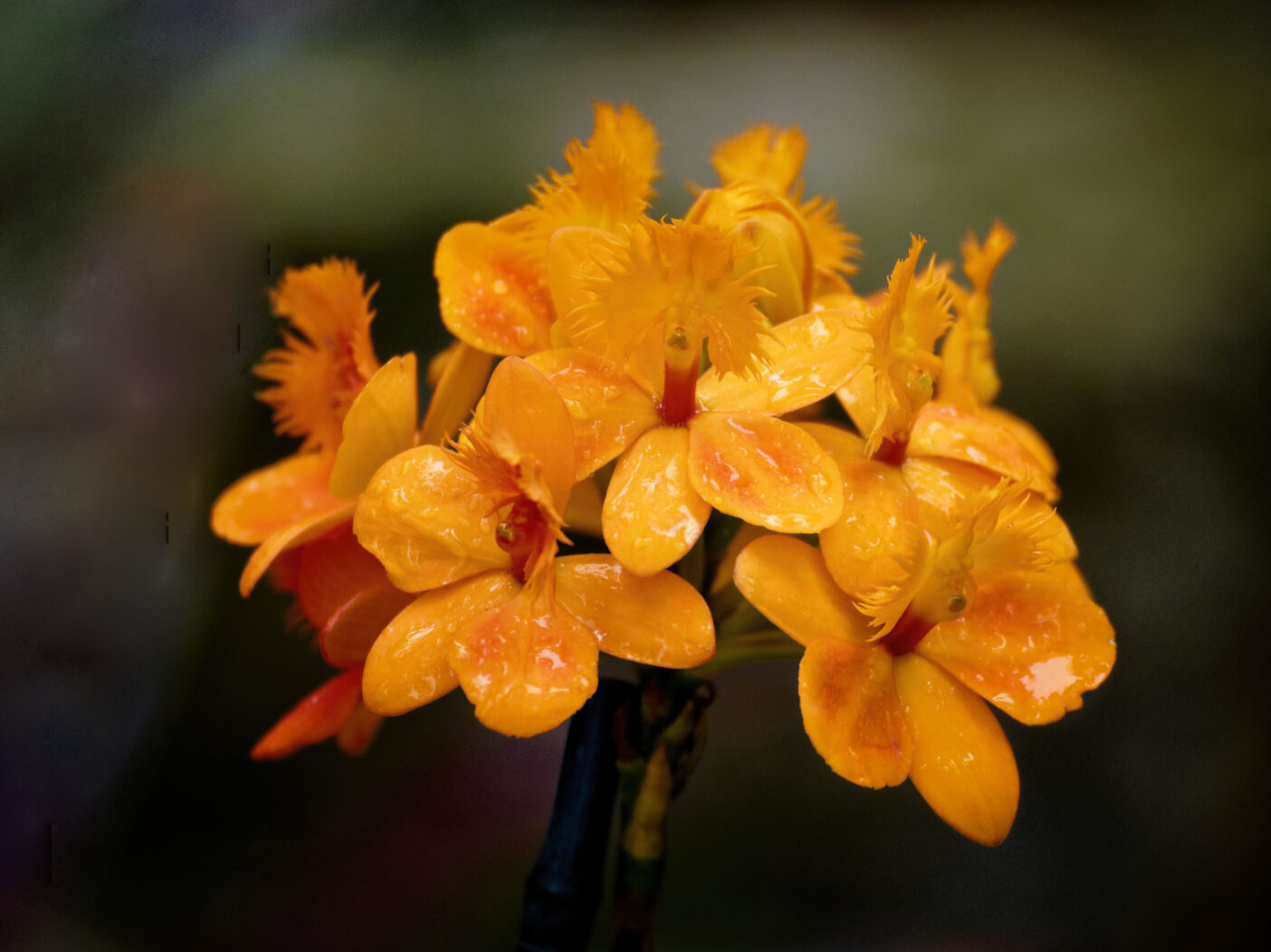
I was introduced to orchids as a child, though I did not know it at the time. I remember my grandmother pointing out a cluster of delicate flowers in the woods behind her Cape Cod house. I loved the name, “lady slippers,” quite possibly because I loved Grandma’s collection of beautiful, feminine shoes, and it seemed fitting that her backyard would host such a plant.
Grandma had few rules, but Cypripedium acaule were strictly “hands off.” I’m not sure if picking them was illegal or simply discouraged. No matter, anything forbidden doubles the allure. I’d look for lady slippers whenever I was in the woods and excitedly point them out to grown-up companions.
I now know that lady slippers belong to the Orchidaceae family, among the world’s largest, most diverse — and possibly most revered — families of flowering plants. They’re so beloved that we are hosting a two-week Orchid Fest, February 14 – 28. The focus on these flowers prompted the childhood reminiscence and this question: Are we humans intrinsically drawn to orchids?
The answer, I’ve come to believe, is “yes!”

My colleagues in the Education and Visitor Services Department introduced me to Orchidelirium, an obsession that swept Europe during the Victorian Era. Legend has it that it started in 1818 when British biologist John Swainson used orchids as packing material in a crate bound for England from Brazil. One bloomed during the voyage, and its striking colors and unusual shape set off a collecting craze that lasted until the 1920s, leaving tropical forests and other habitats ravaged in its wake.
“They clear-cut the forests to collect all the orchids, and then often burned the areas because they didn’t want the other orchid hunters to know where they got them,” says Education Programs Assistant Patrick Deja, who has studied the period extensively.
Patrick points out the genus that’s believed to have launched the obsession, the cattleya, and I can see why Europeans were so intrigued, even if I certainly can’t justify their behavior. In the LaGrippe Orchid Garden, a white one, bigger than my fist, gleams under full sun. One of its petals, the one that juts forward and is known as a labellum, is yellow at the center and magenta along the edge. The coloring of our cattleya is a result of hybridization, but orchids in their natural state can be just as stunning.
Orchid hunting erupted into a full-blown enterprise. One hunter, Benedikt Roezl, culled eight tons of orchids from South America. Frederick Sander, the “Orchid King,” employed 23 hunters and built 60 greenhouses to hold his stash. Men like them were willing to risk their lives for a flower. News accounts from that era reported hunters captured by natives, felled by disease, and attacked by wildlife, including a tiger.
All for a joy that was fleeting — at least in Orchidelirium’s early years. Collectors built hot, air-tight structures known as “stoves” to house the plants — not realizing that many of the species collected came from higher altitudes and preferred more temperate conditions, not to mention sunlight and fresh air. Flowers that made it to market often did not last much longer because buyers did not know how to care for their new plants. Early collectors did not understand the difference between terrestrial orchids, which grow in soil, and epiphytic ones that draw nutrients from air and water through aerial roots. In short, these botanical treasures were more akin to cut floral arrangements than potted perennials.
“That was the biggest issue — (collectors) would get orchids, they would bloom for a while, and then they’d die or they wouldn’t flower again, and they couldn’t figure out why,” Patrick says.
Eventually, through trial and error, Europeans learned how to care for the plants. The craze waned as collectors learned to grow orchids from seed in the 1920s.
“That was the turning point,” Patrick says. “Mostly.” He shows me a black-and-white photo of a wagon brimming with orchids stripped from the Everglades even after the South American and Southeast Asian madness had ended.

Today, orchids are so easy to reproduce (contemporary commercial varieties are mostly clones) that Publix offered them as a BOGO deal a few weeks back.
But that doesn’t mean they’ve lost their mystique.
“Orchids are still astonishing people today,” says Patrick. He and others on our staff routinely surprise guests with all sorts of orchid facts — that vanilla in an orchid (Patrick shows me the yellow buds on a vanilla vine growing near the Chabraja Visitor Center); that they flourish in places as disparate as Alaska (with 25 native species) and Hawaii (with a surprising three native species); that orchids are notorious tricksters, mimicking the look or smell of other plants or insects to lure pollinators; that ancient cultures used orchids in medicine; that orchids and fungus have an intricate interdependence.
My grandmother’s “hands-off” approach was right. North America is home to more than 200 orchid species; more than half of which are endangered or threatened somewhere within their native range. Poaching remains a problem. In fact, an infamous case unfolded right here in Collier County when plant collector John Laroche and a group of Seminoles were arrested in 1994 for poaching rare orchids in the Fakahatchee Strand State Preserve Park. The story was immortalized in The Orchid Thief, a nonfiction account of the crime.
That’s probably why Patrick says the obsession with orchids “never truly ends.”
Orchidelirium is just one topic that we’ll explore during Orchid Fest. A complete schedule of events is available on our website. If, like me, you are captivated enough to contemplate purchasing orchids for your home, or you just want to see the full spectrum of Orchidaceae magnificence, be sure to attend the festival during its second weekend, February 22 – 23, when the Naples Orchid Society’s Show & Sale is in full swing at the Garden.
 About the Author
About the Author
Jennifer Reed is the Garden’s Editorial Director and a longtime Southwest Florida journalist.


